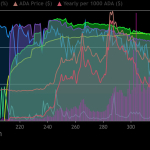
In the realm of cryptocurrency, the term “staking” has gained significant traction, especially within the Cardano community. But what does staking crypto mean, and why is it crucial for platforms like Cardano? Let’s delve into this concept to unravel its importance and how it pertains specifically to Cardano.
What Does Staking Crypto Mean?
At its core, staking crypto involves participating in the validation and verification of transactions on a blockchain network. Unlike traditional proof-of-work (PoW) systems, which rely on mining, staking relies on validators who hold and “stake” their coins to support the network’s operations.
When users stake their cryptocurrency, they contribute to the security and functionality of the network. In return for their participation, stakers receive rewards, typically in the form of additional tokens. This process not only incentivizes network participation but also helps maintain its integrity and decentralization.
Staking on Cardano
Cardano, a third-generation blockchain platform, is renowned for its innovative approach to scalability, interoperability, and sustainability. Central to its operation is the concept of staking, which plays a pivotal role in its consensus mechanism known as Ouroboros.
In the Cardano ecosystem, staking involves delegating ADA tokens (the native cryptocurrency of Cardano) to a stake pool. These stake pools, operated by individuals or entities, are responsible for validating transactions and producing new blocks on the blockchain.
By staking their ADA, users actively participate in the network’s governance and decision-making processes. They contribute to the security and decentralization of Cardano while earning rewards for their involvement.
Benefits of Staking on Cardano
- Passive Income: Staking ADA allows holders to earn passive income in the form of additional tokens. The more ADA they stake, the higher their potential rewards.
- Network Security: Staking enhances the security of the Cardano network by incentivizing active participation and discouraging malicious actors from attempting attacks.
- Decentralization: Cardano’s staking mechanism promotes decentralization by empowering individual users to participate in the network’s governance, rather than relying on centralized entities.
- Sustainability: Unlike energy-intensive proof-of-work systems, Cardano’s proof-of-stake (PoS) mechanism is more energy-efficient and environmentally friendly, aligning with principles of sustainability.
How to Stake ADA on Cardano
- Choose a Wallet: Select a compatible wallet that supports ADA staking. Popular options include Daedalus and Yoroi. For an overview of more supporting walllets see our detailed guide.
- Delegate to a Stake Pool: Delegate your ADA holdings to a stake pool of your choice. Consider factors such as pool performance, fees, and reputation when making your selection.
- Earn Rewards: As your chosen stake pool validates transactions and produces blocks, you’ll start earning rewards in the form of additional ADA tokens.
Conclusion
In summary, staking crypto, particularly on platforms like Cardano, is a fundamental aspect of blockchain technology. It incentivizes active participation, enhances network security, promotes decentralization, and fosters sustainability. By understanding and engaging in staking, users not only contribute to the growth of Cardano but also stand to benefit from its rewards system. Embracing staking is not just about earning passive income; it’s about actively shaping the future of decentralized finance and technology.


